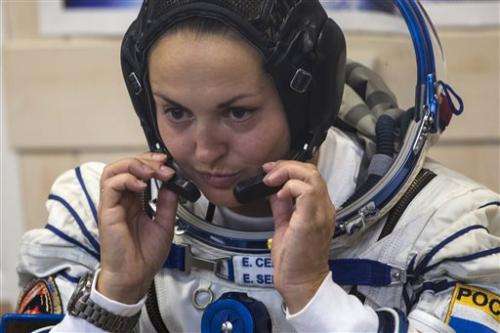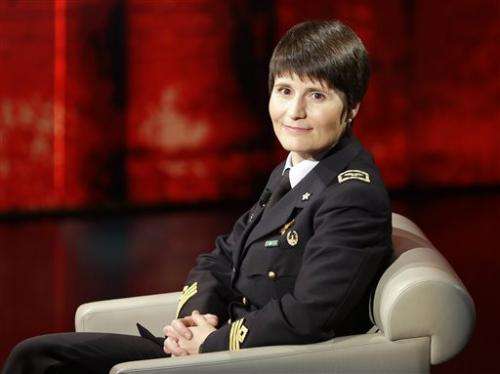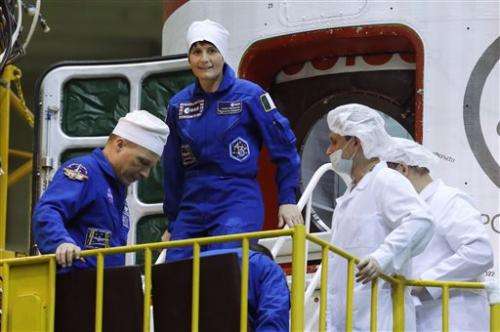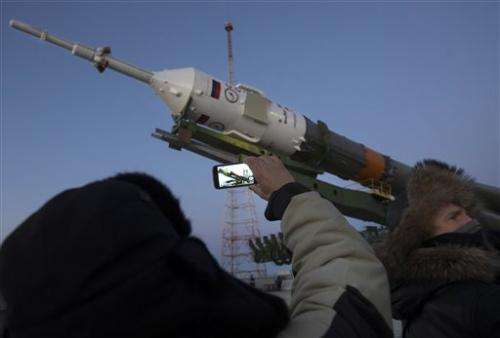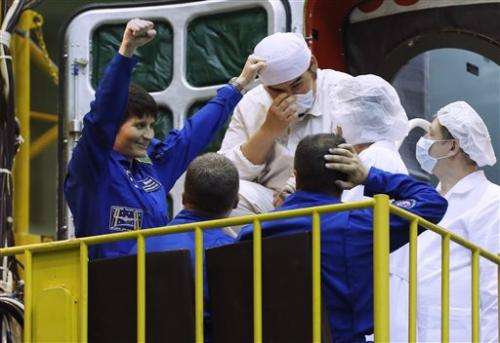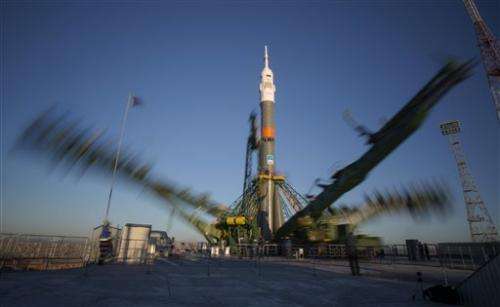In this Sept. 25, 2014, file photo, Russian cosmonaut Elena Serova, the crew member of the mission to the International Space Station, ISS, attends pre-launch preparations at the Russian leased Baikonur cosmodrome, Kazakhstan. Samantha Cristoforetti, Italy's first female astronaut, is set to rocket into orbit this weekend from Kazakhstan, bound for the International Space Station. There, she will join Serova. It will be just the second time in the International Space Station's 16-year history that two women make up the six-member crew. (AP Photo/Pavel Golovkin, File)
For the 21st-century spacewoman, gender is a subject often best ignored. After years of training for their first space mission, the last thing Samantha Cristoforetti and Elana Serova want to dwell on is the fact they are women.
Cristoforetti, Italy's first female astronaut, is set to rocket into orbit this weekend from Kazakhstan, bound for the International Space Station. There, she will join Russia's Serova, a rarity in her homeland's male-dominated cosmonaut corps.
It will be just the second time in the space station's 16-year history that two women make up the long-term, six-member crew.
Just don't ask Cristoforetti or Serova about the gender issue.
"Space is what I do for work, and that's what I think about it: It's my work," Serova said in a NASA interview before launch in late September.
Cristoforetti, 37, a fighter pilot and captain in the Italian Air Force, has managed to sidestep most if not all gender questions leading up to Sunday's planned launch.
Serova tried to do the same. But before the 38-year-old engineer climbed aboard a Russian Soyuz rocket, Russian reporters asked if she was taking up makeup and wondered how she would wear her hair during her six-month mission.
Serova ignored the makeup question. As for her hairdo, she shot back:
"I have a question for you—why don't you ask the question about Alexander's hair, for example," she said, referring to crewmate Alexander Samokutyaev seated next to her at the news conference. "I'm sorry, this is my answer. Thank you. More questions?"
To Americans old enough to remember, it felt like a time machine hurtling back to 1983 and Sally Ride's first flight into space when she got similar questions.
In this Oct. 5, 2014, file photo, Italian astronaut Samantha Cristoforetti smiles during the Italian State RAI TV program "Che Tempo che Fa", in Milan, Italy. Cristoforetti, Italy's first female astronaut, is set to rocket into orbit this weekend from Kazakhstan, bound for the International Space Station. There, she will join Elana Serova. It will be just the second time in the International Space Station's 16-year history that two women make up the six-member crew. (AP Photo/Antonio Calanni, File)
Both Serova and Cristoforetti will spend six months aboard the 260-mile (429-kilometer)-high complex, following in the footsteps of nine American women who logged lengthy stays. Two of those U.S. women shared the place in 2010, with four men. Another two women rose to station commander rank.
Cristoforetti is the first woman assigned to a lengthy space station mission by the European Space Agency, fresh off a spectacular comet landing of a spacecraft.
Serova is one of only four Russian women to fly in space and the first to live at this space station. It was 1963 when Russia launched the world's first spacewoman, Valentina Tereshkova, beating America by two full decades, and 1984 when it flew the first world's female spacewalker, Svetlana Savitskaya.
In this May 24, 2014, file photo, European Space Agency's astronaut Samantha Cristoforetti, of Italy, center, exits a Russian Soyuz TMA-13M spaceship during training in an assembly shop in Russian leased Baikonur cosmodrome, Kazakhstan. Cristoforetti, Italy's first female astronaut, is set to rocket into orbit this weekend from Kazakhstan, bound for the International Space Station. There, she will join Elana Serova. It will be just the second time in the International Space Station's 16-year history that two women make up the six-member crew. (AP Photo/Dmitry Lovetsky, File)
For the young Serova, those two pioneering Russian spacewomen were role models.
"They had very impressive personalities, showing everybody that if somebody wants to achieve something they can do it," Serova said in the NASA interview.
Serova and Cristoforetti's joint flight comes as U.S. medical researchers take an updated look at gender differences in space. With space station missions spanning a half-year and expected to last considerably longer on trips to Mars, NASA wants to make sure all astronauts—male and female alike—stay safe and healthy.
This month, the Journal of Women's Health published a series of studies on the impact of gender on adapting to space.
It turns out that women tend to suffer more faintness when trying to stand upon immediate return to Earth and also more vertigo, according to the report, and they appear to lose more blood plasma during spaceflight. Male astronauts seem to suffer more vision impairment due to intracranial pressure in orbit than women, although the difference is not statistically significant given the small number of subjects, researchers noted.
People take photos of Russia's Soyuz-FG booster rocket with the space capsule Soyuz TMA-15M that will carry a new crew to the International Space Station (ISS), fixing vertical at the launch pad in Russian leased Baikonur cosmodrome, Kazakhstan, Friday, Nov. 21, 2014. Start of the new Soyuz mission is scheduled on Monday, Nov.24.(AP Photo/Dmitry Lovetsky)
There also are concerns about astronauts' reproductive health stemming from space radiation as well as weightlessness.
"Many questions remain unanswered," the executive summary concluded.
Dr. Saralyn Mark, an endocrinologist who serves as a government science adviser, said in an accompanying commentary that the findings can still be useful in shaping health-related policies and procedures.
"Understanding small differences is especially important in the extreme environment of space where even small differences in how the body adapts can translate into critical health outcomes," wrote Mark.
In this May 24, 2014, file photo, European Space Agency's astronaut Samantha Cristoforetti of Italy, left, raises her arms while standing next to a Russian Soyuz TMA-13M spaceship during training in an assembly shop in Russian leased Baikonur cosmodrome, Kazakhstan, Cristoforetti, Italy's first female astronaut, is set to rocket into orbit this weekend from Kazakhstan, bound for the International Space Station. There, she will join Elana Serova. It will be just the second time in the International Space Station's 16-year history that two women make up the six-member crew. (AP Photo/Dmitry Lovetsky, File)
Mark and the other authors and researchers—representing NASA, the National Space Biomedical Research Institute in Houston and various universities—recommend that more women fly in space, and more astronauts of both genders participate as test subjects.
That will be challenging given the overwhelming number of male astronauts. Of NASA's 43 current active astronauts, 11 are women.
NASA hopes to expand its medical know-how with a yearlong mission by two astronauts—an American and a Russian—set to begin at the space station in March. Both are men.
In this long exposure picture, service towers lift to the Russia's Soyuz-FG booster rocket with the space capsule Soyuz TMA-15M that will carry a new crew to the International Space Station (ISS), at the launch pad at the Russian leased Baikonur cosmodrome, Kazakhstan, Friday, Nov. 21, 2014. Start of the new Soyuz mission is scheduled on Monday, Nov.24.(AP Photo/Dmitry Lovetsky)
More information: NASA: tinyurl.com/ld3zt24
European Space Agency: www.esa.int/ESA
Journal of Women's Health: tinyurl.com/d8mgyll
Journal information: Journal of Women's Health
© 2014 The Associated Press. All rights reserved.
